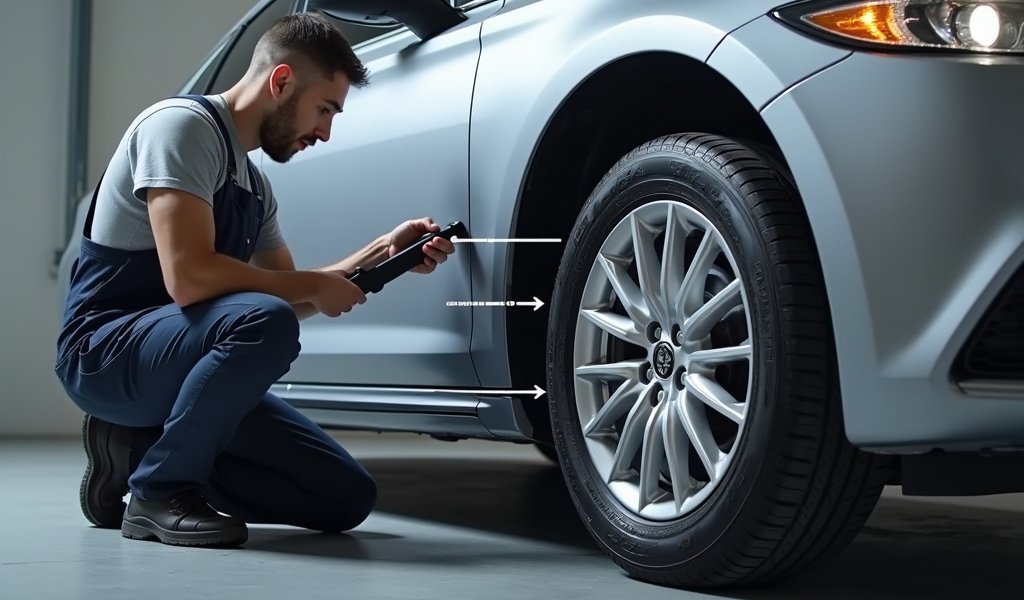Overview
Run flat tires provide temporary mobility after punctures but have strict repair limitations including distance constraints (50-100 miles), specific damage parameters (center tread punctures under 1/4 inch only), and require specialized technicians for proper assessment. The article emphasizes that sidewall damage is never repairable, tire age/wear should factor into repair decisions, and sometimes replacement is the safer and more economical long-term option despite higher initial cost.
Table of Contents
- Understanding Run Flat Tires: Your Safety Net on Wheels
- Tip 1: Driving Distance Limits – How Far Can You Really Go?
- Tip 2: What Damage Can Actually Be Repaired?
- Tip 3: Finding Qualified Specialists – Not All Shops Are Equal
- Tip 4: Age and Wear Considerations – When Repair Isn’t Worth It
- Tip 5: Understanding the True Cost Implications
- Conclusion: Balancing Safety and Smart Decisions
- Frequently Asked Questions
Understanding Run Flat Tires: Your Safety Net on Wheels
Picture this: you’re cruising down the highway when suddenly your steering wheel starts to shimmy like a belly dancer. That sinking feeling in your gut tells you what you already know – you’ve got a flat tire. But wait, your car keeps rolling along, giving you precious time to find a safe spot. That’s the miracle of run flat tires in action.
Run flat tires are like the unsung heroes of the automotive world. These engineering marvels incorporate reinforced sidewalls that bear your vehicle’s weight even after air pressure takes a nosedive. As a mechanic who’s seen countless drivers rescued by this technology, I can tell you they’re worth their weight in gold when trouble strikes.
But here’s the rub – these roadside saviors aren’t invincible. Run flat tire repair limitations exist, and understanding them is crucial for both your safety and your wallet. After two decades under the hood, I’ve seen too many drivers make costly mistakes simply because they didn’t grasp these critical boundaries.
Let’s pop the hood on the five most important things you need to know about run flat tire repair limitations, so you can make smart decisions when the rubber meets the road – or when it meets that nail in the construction zone.
Tip 1: Driving Distance Limits – How Far Can You Really Go?
When your run flat tire catches a puncture, it’s like having a spare built right in – but with a ticking clock. Most manufacturers design these tires to carry you between 50-100 miles after losing pressure. Think of it as your “get out of jail free” card, not a permanent solution.
This isn’t just a recommendation – it’s a hard limit based on serious engineering constraints. Push beyond it, and you’re gambling with your safety. I’ve seen the aftermath when drivers stretch these limits, and it ain’t pretty.
Several factors influence your actual safe driving range:
- Vehicle weight (heavier vehicles create more stress)
- Your speed (stick under 50 mph – this isn’t the time for your NASCAR dreams)
- Ambient temperature (extreme heat accelerates deterioration)
- Road conditions (rough roads are particularly punishing)
- The severity and location of damage
How can you tell when you’re pushing your luck? Your car will start to handle like a shopping cart with a wobbly wheel. The steering might pull, unusual vibrations could develop, or you might hear a rhythmic thumping sound. These are all distress signals from your tire screaming, “Enough already!”
Remember to reset your tire pressure monitoring system once you’ve addressed the issue. This ensures your dashboard isn’t lighting up like a Christmas tree after repairs are complete.
The bottom line? When your run flat takes a hit, don’t treat those miles as a challenge – they’re a lifeline to get you somewhere safe. Use them wisely.

Tip 2: What Damage Can Actually Be Repaired?
Not all punctures are created equal in the world of run flat tires. Some can be patched up like new, while others spell the end of the road for your tire. After fixing countless flats over the years, I’ve developed a pretty good sense for what’s salvageable and what’s headed for the recycling pile.
Generally speaking, your run flat tire might be repairable if:
- The puncture is in the central tread area (the middle 75% of the tread width)
- The hole is 1/4 inch or smaller (about the diameter of a pencil)
- The damage is a clean puncture, like from a nail or screw
- You stopped driving within the recommended distance limit
On the flip side, you’re looking at replacement if:
- There’s any sidewall damage (even small cuts can compromise the reinforced structure)
- The puncture exceeds 1/4 inch in diameter
- You’ve got multiple punctures close together
- The damage is a cut or tear rather than a puncture
- You drove on the tire with significantly low pressure for too long
The sidewall deserves special mention here. In conventional tires, sidewall damage is already serious business, but with run flats, it’s an absolute deal-breaker. Those reinforced sidewalls are the backbone of the entire run flat system – damage here is like a crack in a dam. There’s no safe repair method, period.
According to tire safety experts at Tire Rack, attempting to repair damage outside these parameters isn’t just unwise – it potentially endangers lives. When in doubt, replacement is the prudent choice.
I’ve seen too many drivers fixate on saving a tire that’s beyond repair. Trust me, the cost of a new tire pales in comparison to the potential consequences of a catastrophic blowout at highway speeds.
Tip 3: Finding Qualified Specialists – Not All Shops Are Equal
Let me paint you a picture I’ve seen too many times: A driver with a damaged run flat pulls into the first tire shop they spot, assumes any technician can handle the job, and drives away with a repair that’s about as reliable as a chocolate teapot. Run flat repairs require specialized knowledge that many general shops simply don’t possess.
Think of it this way – would you trust a plumber to rewire your house? Both are skilled trades, but they require different expertise. The same principle applies to run flat tire repairs.
When seeking qualified help, look for shops that:
- Display certification from major run flat manufacturers (Bridgestone, Michelin, Continental, etc.)
- Have specialized equipment designed specifically for run flat inspection and repair
- Employ technicians with documented run flat-specific training
- Have substantial experience with your particular tire brand
Don’t be shy about asking pointed questions like:
- “How often do you work on run flat tires?”
- “What specific procedures do you follow for run flat repairs?”
- “Do you follow the tire manufacturer’s repair guidelines to the letter?”
- “Will you perform comprehensive pressure testing after the repair?”
A truly qualified specialist might sometimes be the bearer of bad news – telling you a tire needs replacement when you hoped for a simple repair. In my experience, this honesty is actually the mark of a trustworthy shop. They’re putting your safety above their profit margin.
Before you even need repairs, I recommend checking your tires thoroughly before any road trip. This proactive approach often helps catch potential issues before they strand you on the highway.
Remember, a properly repaired run flat tire should perform just as safely as it did before the damage. If a shop can’t confidently guarantee that outcome, keep driving – preferably to a more qualified establishment.
Tip 4: Age and Wear Considerations – When Repair Isn’t Worth It
Here’s something many drivers don’t realize: even if your run flat tire has technically repairable damage, the tire’s overall condition might make fixing it about as sensible as putting a fresh coat of paint on a rusting car. Age and wear are critical factors that can render repairs pointless or even dangerous.
Rubber compounds are like fine wine in reverse – they don’t improve with age. They degrade through a process called oxidation, which happens whether the tire is rolling down highways or sitting pretty in your garage. This invisible aging process is like termites in your house’s foundation – you can’t always see the damage until it’s too late.
Most tire manufacturers and safety experts recommend replacing tires once they hit the six-year mark, regardless of tread depth or visible condition. The National Highway Traffic Safety Administration backs this guidance, noting that aging affects a tire’s internal structure in ways that aren’t visible to the naked eye.
Tread depth is another crucial consideration. While the legal minimum in most states is 2/32 of an inch (about the distance to Lincoln’s head on a penny), run flat tires should be replaced earlier – typically around 4/32 of an inch. Why? Because these specialized tires need optimal tread to handle the additional stresses they face, especially when operating at reduced pressure.
Ask yourself these questions before authorizing a repair:
- Is this tire more than four years old?
- Does the tread depth measure less than 4/32 of an inch?
- Are there signs of uneven wear, cracking, or weathering?
- Has the tire been repaired previously?
If you answered “yes” to any of these, you’re likely better off investing in a new tire rather than repairing the old one. I’ve seen too many drivers throw good money after bad, only to find themselves replacing the same tire a few months later anyway.
Remember, your tires are the only parts of your vehicle that actually touch the road – they’re not the place to cut corners when it comes to safety.

Tip 5: Understanding the True Cost Implications
Let’s talk turkey about what hits closest to home for most of us – our wallets. When you’re staring down a run flat tire issue, the price difference between repair and replacement can feel like comparing a corner store coffee to a fancy barista creation. But making decisions based solely on the initial price tag can be penny wise and pound foolish.
Run flat tire repairs typically run about 30-50% more expensive than conventional tire repairs, reflecting the additional expertise, time, and specialized equipment required. You might expect to shell out $40-70 for a professional run flat repair, while a brand-new replacement could set you back $200-500 depending on your vehicle and tire specifications.
That price gap makes repair tempting, but consider the full financial picture:
- A properly repaired run flat typically has a shorter remaining lifespan
- If the repair fails prematurely, you’ll end up paying for both the repair AND replacement
- Some tire warranties become void after repairs
- A failed repair could potentially damage other components of your vehicle
- Some insurance policies will cover replacement but not repair
I’ve seen countless drivers opt for the cheaper repair option, only to be back in the shop a few months later needing a full replacement anyway. That’s like paying for your dinner twice – not a recipe for financial success.
Here’s a pro tip from someone who’s been in the trenches: if you’ve got a set of matching run flats with significant tread life left, and one needs replacement, consider replacing them in pairs (both fronts or both rears). This maintains balanced handling and traction, especially important in performance vehicles.
For emergency situations, having a quality portable tire inflator on hand can be invaluable. While it won’t fix a puncture, it can help maintain pressure in a slow leak situation until you reach a repair facility.
Remember, the cheapest option today isn’t always the most economical choice in the long run. Sometimes spending more upfront saves you money, headaches, and potential safety issues down the road.
Conclusion: Balancing Safety and Smart Decisions
When it comes to run flat tire repair limitations, we’re walking a tightrope between safety, convenience, and financial prudence. These remarkable tires have revolutionized roadside emergencies, but they demand respect and understanding to deliver on their promise.
Throughout my years turning wrenches and advising drivers, I’ve seen how informed decisions about run flat tire repairs can make the difference between a minor inconvenience and a major headache – or worse, a dangerous situation.
Let’s recap what we’ve covered:
- Respect the distance limitations after a puncture – they’re there for good reason
- Understand that not all damage is repairable, especially sidewall issues
- Find truly qualified specialists who know run flat technology inside and out
- Consider age and wear before deciding whether repair makes sense
- Look beyond the immediate price tag to understand the true cost implications
Remember that run flat tires are sophisticated safety systems – not just rubber donuts that keep your rims off the pavement. They deserve the same careful consideration you’d give to your vehicle’s brakes or airbags.
The next time you find yourself limping along on a compromised run flat, I hope these insights help you make choices you won’t regret. After all, the best repair is one that keeps you safely on the road for the long haul – both literally and figuratively.
Drive safely, friends, and remember: when it comes to your tires, cutting corners just leaves you going in circles.
Frequently Asked Questions
Can I repair a run flat tire myself?
DIY repairs on run flat tires are strongly discouraged. The specialized construction requires professional assessment and equipment to ensure safety after repair.
Are run flat tires more expensive to repair than regular tires?
Yes, run flat tire repairs typically cost 30-50% more than standard tire repairs. This reflects the specialized equipment and expertise required.
Can I replace just one run flat tire, or do I need to replace them in pairs?
For optimal handling and safety, it’s recommended to replace run flat tires in pairs (both front or both rear). This maintains balanced traction and performance.
How can I tell if my car has run flat tires?
Look for “RFT,” “ZP” (Zero Pressure), “SSR,” or “ROF” markings on the tire sidewall. Alternatively, check your vehicle owner’s manual or the absence of a spare tire might indicate run flats.
Do I still need to carry a spare if I have run flat tires?
Most vehicles equipped with run flats don’t come with a spare. The run flat technology effectively serves as your emergency spare, giving you time to reach a repair facility.

